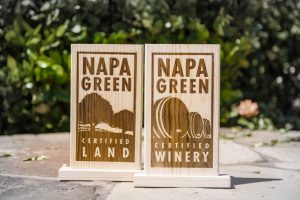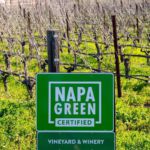
Napa Green, which offers land and winery sustainability certifications, will this year become its own non-profit, the Napa Valley Vintners announced Monday. The certification program was previously supported financially by the Vintners, who say that taking a step back will allow Napa Green to grow and expand outside of wine and into the hospitality industry. - Bob McClenahan
Napa Green, aided by Napa Valley Vintners, to become nonprofit organization
- SARAH KLEARMAN | NAPA VALLEY REGISTER |
- February 10, 2020
Napa Green, the Napa Valley wine industry’s sustainability certification, will this year become its own nonprofit, the Napa Valley Vintners announced in a press release Monday.
The program as it exists currently certifies wineries and vineyards in Napa County as sustainable, curating environmentally friendly business and farming practices. Established in the early 2000s as a collaborative industry effort to promote sustainability, Napa Green has a roster of community stakeholders. They include the Napa Valley Vintners, which has played an instrumental role in program growth.
The nature of the program will not change, according to NVV’s Associate Director of Industry Relations Michelle Novi: it will continue to provide third-party certifications and center on sustainability. The Vintners have been involved with Napa Green almost since its formation, she said, providing the program with organizational and financial support.
Napa Green has grown considerably since that earliest iteration. What was once an effort to protect the watershed of the Napa River has grown into a program that certifies both wineries and vineyards, and whose membership has steadily risen over time. Now, Novi said, NVV feels that taking a step back will encourage more positive growth.
“We got behind Napa Green in a big way, early on, and we’ve dedicated a lot of resources and a lot of time to grow program participation,” Novi said of the Vintners. “Through that process, we identified the fact that Napa Green really needed to be its own entity so it could grow even more.”
Anna Brittain, who currently oversees program operations, will step in to lead Napa Green, the Vintners said. Brittain, who joined with the Vintners in 2015 to help oversee the program, will continue to help shape its future as Napa Green’s executive director.
“Even when I came on board five years ago to help manage growth, we were talking about what would happen in 2020,” Brittain said. “It was: who’s going to keep carrying forward the rigor and the re-certification, not just new certifications? That’s been swirling in our heads ever since we started the push.”
She’s referring to the Vintners’ goal to have 100 percent of their eligible membership Napa Green certified by the end of this year. The group has since grown eligible member participation from something like 30% to its current level at around 80%, Novi said. The organization currently has 90 certified member wineries; a similar number are “in the pipeline” to become certified, Brittain added. More still have received the land certification.
Enrollment has spiked over the last few months, Brittain said, and she’s expecting more members as summer approaches. July will mark the Regional Water Board’s deadline for new, higher standards for vineyard waste discharge requirements, she explained, and Napa Green’s land certification process is a streamlined way for growers to ensure their compliance.
The Vintners’ goal of 100% participation from eligible members by the end of this year is also approaching, Novi said. As part of their support for Napa Green, a portion of NVV member dues have gone toward funding. The program is also indirectly supported through funds from PG&E, which has partnered with Napa Green partner Napa County Energy Watch to subsidize the energy portion of the audits Napa Green performs on member wineries, according to Brittain. That will end in June as the utility reassesses its finances following another turbulent year.
The program’s new non-profit status means the membership structure and business model will have to be changed, Brittain said.
“Until now, a winery has only had to pay a $200-$400 fee for the energy audit,” Brittain added, referring to the process wineries undergo to assess their use of resources and waste production. (That $200-$400 range for the audits is a subsidized price for NVV members; Novi said the true cost is closer to $2,000).
“With us as an independent nonprofit, that is going to have to change, and we’re still figuring out exactly what that’s going to look like,” Brittain said.
She said members should expect to pay dues following the transition, a model followed by the other wine industry sustainability programs available in wine grapegrowing regions in the United States.
Still, Novi noted: the removal of funding exclusively from Vintners’ members means the program is free to expand beyond the wine industry. And that’s something Napa Green is looking seriously at doing, Brittain said. She hopes to be involved with sustainability in the hospitality industry, eventually expanding the program into hotels, restaurants and potentially even events.
“A lot of folks are already doing a lot with sustainability,” Brittain said, of the hospitality industry. “We’re seeing what people are already doing and their interest around certification and third-party verification – and there’s definitely opportunity there.”
The group is also considering launching a Napa Green winery passport geared towards consumers with an eye towards the environment, Brittain said.
As the program expands, so will its leadership. A new board of directors, including Novi, will help to guide Napa Green’s development. Novi’s seat on the board will ensure the Vintners are able to continue providing support and guidance, she said, as will the presence of members of local environmental groups and residents who will join her on the board. Board membership is “female dominated,” Brittain said, noting the group was careful to include individuals from outside the wine industry in their member selections.
“It’s just an exciting time for the program,” Novi said. “It’s grown into a community of people that are committed to operating as sustainably as possible under Anna’s leadership, and we’re excited to see that community grow.”
Editor’s note: this story has been modified to reflect that the vineyard waste discharge requirements are set by the Regional Water Board and that PG&E funds are contributed to Napa Green via a partnership with PG&E partner Napa County Energy Watch.
You can reach Sarah Klearman at (707) 256-2213 or sklearman@napanews.com.
Making the commitment to third party certification takes time and effort, but it is worth it to demonstrate our commitment to the community and to protect our watershed, our land and the air we breathe.
- Susan Boswell, Chateau Boswell Winery


